|
Introduction
This
summary of the invasion and capture of Port Said
in November 1956 by Anglo-French forces is built
around the original London Gazette despatch
which is quoted in full in the right hand
column. As with other official despatches, this
one is short, to the point, accurate as far as
official secrecy and political expediency will
allow, and above all highly readable.
A
variety of background material appears in this
left hand column, mostly of a naval nature,
hopefully to give some additional colour to the
story. Sources of information are given where
appropriate, and as usual, Photo Ships has
provided most of the ship images.
No
comments are made on the political reasons for
invading Port Said after Egyptian President
Nasser nationalised the Suez Canal, nor on the
Anglo-French evacuation. What should perhaps be
pointed out is that a complex military campaign
involving two nations and three armed forces,
with little notice and limited resources, was
carried out successfully in a very short time,
and with few British and French casualties. As
always in such modern wars, civilian casualties
were heavy.
Contents
London
Gazette Despatch (right)
Events
in outline
Background
maps
Some
of the ships, aircraft and armour taking part
Casualties
British Honours and Awards
The
experience of Lt-Cdr James (Jim) Summerlee,
helicopter pilot, HMS Eagle
Other
sources
EVENTS
IN OUTLINE
"Operation
Musketeer" appears to apply to the joint
Anglo-French (Allied) and Israeli attempt to
wrest control of the Suez Canal out of Egyptian
hands, although it generally seems to be
associated with the invasion of Port Said and
planned advance along the Suez Canal:
1956
August
- Allied forces start to concentrate in Eastern
Mediterranean; planning and training continues
on in to October.
October
1956
29th
- Israel attacks across the Sinai.
30th
- Allied forces ordered to initiate Egyptian
operations leading to the occupation of Port
Said, Ismailia and Suez.
31st
- Allied air attacks, aimed at destroying the
Egyptian Air Force, are started by RAF bombers
late that afternoon.
31st/1st
November - south of Suez in the Red Sea, cruiser
HMS Newfoundland sinks Egyptian frigate Domiat
November
1956
1st -
Starting at daylight, Allied shore-based and
carrier aircraft continue to attack Egyptian
airfields
2nd
- By the end of the day, the destruction of
the Egyptian Air Force is all but complete,
although air attacks continue
5th
- Initial airborne assault by British
paratroopers to the west of Port Said and
French to the south.
6th
- Airborne drops continue, but it is now time
for the seaborne assault by RN helicopters
carrying Royal Marine commandos - the first
such major landing in history. As Port Said is
cleared, Allied forces reach El Cap,
23
miles south near to Al Qantara where they
stop. A UN-sponsored cease-fire is scheduled
for midnight.
December
1956
22nd
- The
evacuation of Anglo-French forces is
completed
BACKGROUND
MAPS
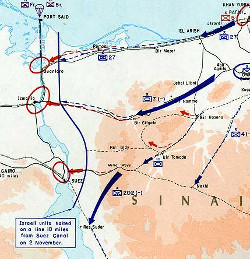 Israeli and
Anglo-French areas of operation
Israeli and
Anglo-French areas of operation

Port Said and northern end of Canal (Google)
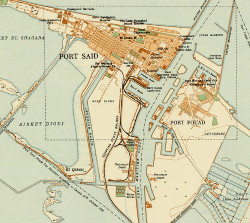
More detailed map of Port Said, published 1936
(American Geographical Society Library). Changes
by 1956 are not known, but many of the
Port Said locations in the Despatch can be found
here. Gamil or El Gamil is 7km west of Port Said
on the Damietta coastal road. In the
enlargement, it is in the area of the green
patch at the top left.
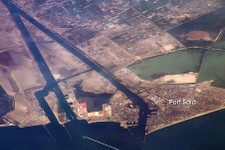 Port
Said from the International Space Station, 2006,
north at bottom (Wikipedia)
SOME
OF THE SHIPS, AIRCRAFT AND ARMOUR TAKING
PART
Note:
FS is used unofficially for French warships
HMS
Tyne, depot/HQ ship
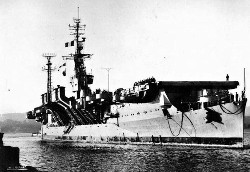
FS Lafayette, carrier
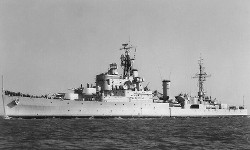
HMS Newfoundland, cruiser
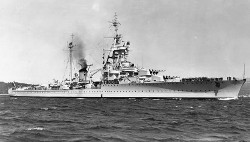
FS Georges Leygues, cruiser
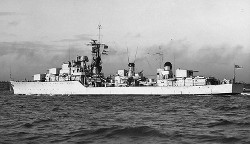
HMS Daring, destroyer
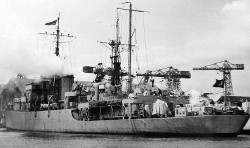
Egyptian frigate Domiat, sunk by
Newfoundland

HMS Anzio, LST. entering Malta
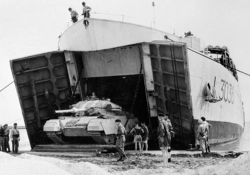
HMS Puncher, LST,
landing Centurion (Wikipedia)
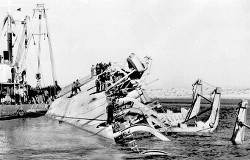
Egyptian LST Akka scuttled in the Canal
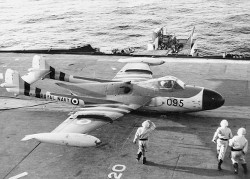
British
Fleet Air Arm Sea
Venom
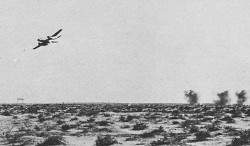
Egyptian, Russian-built Il-28 light bomber
in action against Israeli Forces in 1967
(Wikipedia)
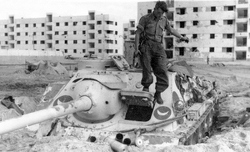
Egyptian, Russian-built SU-100 tank
destroyer captured by 3 Para (Airborne
Forces Archive/Daniel Gent)
CASUALTIES*
ROYAL NAVY
with thanks to Don Kindell
6th
November 1956
Royal Marines, Suez War, Anglo-French
Invasion of Port Said, Egypt
40 Commando
DUDHILL, Lorin, Marine, RM 15070,
killed
FUDGE, Ronald J, Marine, RMV 202128,
killed
MCCARTHY, Peter W, Act/Lieutenant, RM,
killed in action
UFTON, Edward A, Act/Lieutenant, RM,
killed in action
42
Commando
DENNIS, Donald H A, Sergeant, RM,
PLY/X 4537, killed by sniper
HOWARD, David, Marine, RM 15145,
killed
PRICE, Bernard J, Marine, RM 11202,
killed
SHORT, Brian J, Marine, RM 11158,
killed
45 Commando
FOWLER, Michael J, Marine, RM 14245,
killed
GOODFELLOW, Cyril E, Marine, RM 13183,
killed
Note:Some
of the Royal Marines, from 45 Cdo, were
killed by "friendly fire" (Wikipedia). An
online account by Corporal(?) Colin
Ireland of 45 Cdo, who was badly wounded
in this attack confirms they were hit by
cannon fire from a single carrier-borne
Wyvern
as they went in to finish off an enemy
position that had just been strafed by
other Wyverns.
OTHER
Details
of other casualties have not been found.
Anglo-French totals are quoted in the
Despatch, but this is only believed to be
up to the cease-fire on the 6 November. It
appears that other Allied casualties
occurred after this date and up to the
Allied evacuation on the 22 December 1956
:
Britain
- 16 killed, 96 wounded
France
- 10 killed, 33 wounded
Egypt
- well in excess of 1,000 military
killed, a portion in action against the
Israelis in the Sinai desert
The
10 Royal Marines killed leaves six from
the other British services, of whom four
were lost with 3 Para (Paradata.org). This
would leave another two killed.
The Despatch lists two more British losses
- (1)
Lieutenant Moorhouse who was
kidnapped (but not recovered)
and (2) an officer of
the Scots Guards ambushed and killed
on the 16 December.
BRITISH
HONOURS and AWARDS
Recorded
in The London Gazette, issue
41092, 4th June 1957
ROYAL NAVY
Fourth Supplement to The
London Gazette
of Tuesday, 4th June, 1957
(Note:
repeating introductory text has been
removed; abbreviations substituted)
THURSDAY, 13 JUNE, 1957
CENTRAL
CHANCERY OF THE ORDERS OF KNIGHTHOOD.
St.
James's Palace, SWI
13th
June, 1957.
The QUEEN has been graciously pleased, on
the occasion of the Celebration of Her
Majesty's Birthday, to give orders for the
following promotions in recognition of
distinguished services in the Operations
in the Near East, October to December,
1956:
Royal
Navy and Royal Marine Officers
Order
of the Bath
Additional Member of the Military Division
of the Second Class, or Knight Commander
(KB)
Vice-Admiral Leonard Francis
DURNFORD-SLATER, CB
Order
of the British Empire
Knight Commander of the Military Division
(KBE)
Vice-Admiral Maxwell RICHMOND, CB, DSO,
OBE
Commanders of the Military Division (CBE)
Commodore Desmond Parry DREYER, DSC, RN
Captain Charles Piercy MILLS, DSC, RN
Captain Theodore Edward PODGER, RN, UK
Salvage Unit
Officers of the Military Division (OBE)
Captain Albert Victor BARTON, Master, RFA
Brown Ranger.
Major Basil Ian Spencer GOURLAY, MBE, MC,
RM, 3 Cdo Brigade, RM
Commander Edward Findley GUERITZ, DSC, RN
Lieutenant-Commander (then Acting
Commander) Lionel Geoffrey LYNE, DSC, RN,
HMS Forth
Commander William Charles SIMPSON, DSC,
RN, HMS Eagle
Members of the Military Division (MBE)
Lieutenant-Commander George Hill CREESE,
RN, HMS Eagle
Lieutenant-Commander John Homersham GOLDS,
RN, HMS Newfoundland
Lieutenant-Commander John Morris JONES,
RN, 895 RNAS
Lieutenant John Arthur Charles MORGAN, RN,
845 RNAS
Lieutenant-Comimander Eric Norman READ,
RN, HMS Kingarth.
Lieutenant-Commander Deryck Arthur Jaimes
SHEPPARD, RN, 810 RNAS.
Lieutenant-Commander Alan Montagu Burleigh
TAYLOR, RN, HMS Eagle.
Royal Navy Ratings and Royal Marine
Other Ranks
British Empire Medal (Military Division) (BEM)
Chief Engine Room Artificer Ernest Walter
BASTIN, DSM, D/MX.54340, HMS Eagle
Acting Yeoman of Signals Reginald DAINTY,
P/JX.581680, HMS Chevron
Chief Aircraft Artificer Russell George
KING, L/FX.75251, 845 RNAS
Chief Petty Officer Cook (S) Royston
Leslie RUSSELL, P/MX.48443. HMS Armada
Chief Airman Harold Reuben Joshua SHOWELL,
L/FX.670678, HMS Albion
Chief Engine Room Artificer Joseph Eric
WHITENSTALL, DSM, P/MX.57728, HMS Bulwark
ADMIRALTY,
Whitehall,
SW1, 13th June. 1957.
The QUEEN has been graciously pleased, on
the occasion of the Celebration of Her
Majesty's Birthday, to give orders for the
following appointments to the
Distinguished Service Order and to approve
the following awards in recognition of
gallant and distinguished services in the
Operations in the Near East, October to
December 1956:
Royal
Navy and Royal Marine Officers
Distinguished
Service Order
Brigadier Reginald William MADOC, OBE. RM,
3 Commando Brigade, RM
Lieutenant-Colonel David Gratiaen TWEED,
MBE, RM, 40 Cdo. RM,
Bar to
the Distinguished Service Cross
Lieutenant-Commander Maurice William
HENLEY, DSC, RN, 893 RNAS.
Lieutenant-Commander
Peter Melville "Sheepy" LAMB, DSC, AFC,
RN, 810 RNAS (Sqdn CO) (see
below)
Distinguished
Service Cross
Lieutenant-Commander Eric Charles DAY, RN,
HMS Forth.
Lieutenant-Commander Royston Leonard
EVELEIGH, RN, 802 RNAS.
Lieutenant-Commander Charles Vyvyan
HOWARD, RN 830 RNAS.
Bar to
the Military Cross
Major Dennis Leolin Samuel St. Maur
ALDRIDGE, MBE, MC, RM, 42 Cdo, RM,
Military
Cross
Major Anthony Patrick WILLASEY-WILSEY.
MBE, RM, 40 Cdo, RM,
Captain Michael Anthony Higham MARSTON,
RM, 40 Cdo, RM,
Lieutenant Stuart Lawrence SYRAD, RM, 45
Cdo, RM
Royal
Navy Ratings and Royal Marine Other
Ranks
Distinguished
Conduct Medal
Corporal Douglas Edward MANT, PO.X.2992,
RM, 40 Cdo, RM
Distinguished
Service Medal
Leading Seaman Thomas DYER, P/JX.163578,
HMS Newfoundland.
Able Seaman Roy Joseph LOADER.
D/JX.912011, HMS Crane.
Military
Medal
Quartermaster Sergeant George Desmond
BUTTERY, PO.X.4096, RM, 40 Cdo, RM
Corporal Michael Edward MEAD, RM11157, RM,
45 Cdo, RM
Marine James Willie CROSSLAND, RM14422,
RM, 40 Cdo, RM
Marine David Kelly DAVIDSON, RM14644. RM,
45 Cdo, RM
Mention
in Despatches
Royal
Navy Officers
Captain John Graham HAMILTON, RN, HMS
Newfoundland
Commander Ian David MCLAUGHLAN, DSC. RN,
HM.S. Chevron
Lieutenant-Commander Peter Everard BAILEY,
RN, HMS Eagle.
Lieutenant-Commander Arthur Bernard Bruce
CLARK, RN, 899 RNAS.
Lieutenant-Commander Derek Arthur FULLER,
RN, 849C (sic) RNAS.
Lieutenant-Commander Brian Haviland
HARRISS, RN, HMS Albion
Lieutenant-Commander Antony Herbert Lane
HARVEY, DSC, RN, HMS Bastion
Lieutenant-Commander Timothy Francis
HEGARTY, RN, HMS Crane
Lieutenant-Commander John Claud JACOB, RN,
845 RNAS.
Lieutenant-Commander Randal von Tempsky
Bernau KETTLE, RN, 804 RNAS.
Lieutenant-Commander David Thomas MCKEOWN,
RN, 802 RNAS.
Lieutenant-Commander Malcolm Harold James
PETRIE, RN, 892 RNAS
Lieutenant-Commander Alfred Raymond
RAWBONE, AFC, RN, 897 RNAS
Lieutenant-Commander John Desmond RUSSELL,
RN, 800 RNAS
Lieutenant-Commander Ronald Arthur
SHILCOCK, RN, 809 RNAS
Lieutenant-Commander James
Henry SUMMERLEE, RN, HMS Eagle (see
below)
Lieutenant-Commander Maurice Arthur TIBBY,
RN, 800 RNAS
Lieutenant-Commander Kenneth
ALAN-WILLIAMS, RN, HMS Portcullis
Lieutenant Ian Bruce LENNOX, RN, HMS
Sallyport
Lieutenant Harry PARKER, RN, HMS Lofoten.
Surgeon Lieutenant John Gwyther BRADFORD,
MB, BS, RN, 45 Cdo, RM,
Acting Surgeon Lieutenant Peter Gordon
HARRIES, MB, BS, RN, HMS Diana.
Sub-Lieutenant (SD) Frank Alexander JUPP,
RN, HMS Newfoundland.
Royal Marine Officers
Lieutenant-Colonel Peter Lawrence NORCOCK,
OBE, RM, 42 Cdo, RM
Lieutenant-Colonel Norman Hastings
TAILYOUR, DSO, RM, 45 Cdo, RM (father
of Major Ewen Southby-Tailyour who
played an important role in the 1982
Falklands War)
Major Richard Dennis CROMBIE, RM, 45 Cdo,
RM
Captain Hamish Brian EMSLIE, MC, RM, 42
Cdo, RM
Captain Jesse Hotchkiss HAYCOCK, RM, 45
Cdo, RM
Captain Richard Francis Gerard MEADOWS,
MBE, RM, 45 Cdo, RM
Captain Frederick Roy SILLITOE, RM, 42
Cdo, RM
Lieutenant (Local Captain) Terrance John
WILLS, RM, 42 Cdo, RM
Lieutenant Rudolph Douglas EDWARDS, RM, 40
Cdo, RM
Lieutenant Timothy John Michael WILSON,
RM, 40 Cdo, RM
Acting Lieutenant Anthony William
RICHARDSON, RM, 45 Cdo, RM
Acting Lieutenant Alistair Dunlop RODGER,
RM, HMS Striker
Royal Navy Ratings
Chief Petty Officer Robert Alec COKES,
P/JX.151267, HMS Chaplet
Chief Petty Officer Telegraphist William
Heron CHISHOLM, DSM, C/JX.142524, HMS
Jamaica.
Chief Engine Room Artificer John James
SEYMOUR, P/MX.52269, HMS Chaplet
Chief Engine Room Artificer Sidney George
WARD, P/MX.56545, HMS Woodbridge Haven
Chief Engineering Mechanic Charles James
SALMON, P/KX.91789, HMS Newfoundland
Chief Electrician Gordon Enderson MORRIS,
D/MX.856466, HMS Eagle
Chief Radio Electrical Artificer George
Haslam WHITTAKER, P/MX.715767, HMS Duchess
Chief Aircraft Artificer Charles Henry
BERRY, L/FX.75018, 892 RNAS
Chief Aircraft Artificer Leonard CARTER,
L/FX.87518, 895 RNAS
Chief Aircraft Artificer Francis Newton
DAVIS, L/FX.76919, 804 RNAS
Chief Aircraft Artificer Patrick Joseph
FOLEY, L/FX.766096, 802 RNAS
Chief Aircraft Artificer Hugh Charles
Cecil HUZZEY, L/.FX.76704, 810 RNAS
Chief Airman Charles Henry FRENCH,
L/FX.857897, HMS Eagle
Aircraft Artificer (O) 1st Class Dennis
HARBIN, L/FX.935430, 895 RNAS
Chief Aircraft Mechanician Reginald Arthur
WILSON, L/FX.75690. 800 RNAS
Sick Berth Chief Petty Officer Joseph
Windsor BENNETT, P/MX.53428, HMS Theseus
Sick Berth Chief Petty Officer Thomas
Arthur GRUNDY, D/MX.49569, HMS Ocean
Chief Petty Officer Cook (S) Claude Henry
BELL, P/MX.52864, HMS Albion
Master-at-Arms Albert Charles NICHOLLS,
P/MX.716378, HMS Tyne
Petty Officer Clifford JAMES, P/JX.801647,
HMS Duchess
Yeoman of Signals George Thomas Warren
RYRTE, D/JX.156879, HMS Manxman
Petty Officer Telegraphist Ronald Joseph
GARRAD, P/JX.712711, HMS Newfoundland
Petty Officer Writer Bernard THOMPSON,
C/MX.849428
Leading Airman Kenneth Edward GAMMER,
L/EX.906108, HMS Eagle.
Leading Airman George James Henry HAZEL,
L/FX.886965, HMS Eagle
Leading Sick Berth Attendant Terence
Francis JENNINGS, D/MX.896612,
HMS Crane.
Naval Airman 1st Class Anthony Brian
WEBSTER, L/FX.917498, HMS Eagle
Sick Berth Attendant Brian Anthony
GREENACRE, D/MX.923667, HMS Eagle
Sick Berth Attendant Stanley George
LlNDFIELD, P/M.932119, HMS Newfoundland
Royal Marine Other Ranks
Sergeant Arthur Henry HOWARTH, Ply.X.5512,
RM, HMS Striker
Sergeant Arthur Thomas George PECK,
Ch.X.5357, RM, 40 Cdo, RM
Sergeant Ernest James SIM, Ch.X.4768, RM,
45 Cdo, RM
Corporal Peter Shand YOUNG, RM.9957, RM,
42 Cdo, RM
Marine John Albert Windsor COX, RM.15050,
RM, 40 Cdo, RM
Marine Alan William MIDDLETON, Po.X-6406,
RM, 42 Cdo, RM
Marine Ronald Frederick SAGGERS,
Po.X.6552, RM, 42 Cdo, RM
OTHERS
For
British Army and Royal Air Forces
Honours and Awards, go to The London
Gazette, issue 41092, 4th June 1957
Any British awards to French servicemen
have not been identified
Analysis of British Gallantry Awards
by Ship/Unit
Additional
Source: The Naval Review, 1957/2
for RNAS Squadrons
COMMAND AND STAFF(?)
Naval Task Force Commanders (2),
KB, KBE
Staff? CBEx2, OBE x 1
PO Writer - staff?,
MID
ROYAL NAVY WARSHIPS
Aircraft Carriers
HMS Albion, BEM, MIDx2 (Seahawk Sqdns
800 & 802, Sea Venom Sqdn 809,
Skyraider Flt from
849)
HMS Bulwark, BEM (Seahawk Sqdns 804,
810, 895)
HMS Eagle, OBE, MBEx2, BEM, MIDx8
(Seahawk Sqdns 897 & 899, Sea
Venom Sqdns 892 & 893, Wyvern Sqdn
830, Skyraider Flt from 849)
Commando-carrying Carriers (845 RNAS,
Whirlwind HAS.22 helicopters)
HMS Ocean, MID
HMS Theseus, MID
Cruisers
HMS Jamaica, MID
HMS Newfoundland, MBE, DSM, MIDx5
Minelayer
HMS Manxman, MID
Destroyers
HMS Armada, BEM
HMS Chaplet, MIDx2
HMS Chevron, BEM, MID
HMS Diana, MID
HMS Duchess, MIDx2
Sloop
HMS Crane, DSM, MIDx2
Depot/HQ Ships
HMS Forth, OBE, DSC
HMS Tyne, MID
HMS Woodbridge Haven, MID
Landing Ship's Tank
HMS Bastion, MID
HMS Lofoten, MID
HMS Portcullis, MID
HMS Sallyport, MID
HMS Striker, MIDx2
Coastal Salvage Vessel
HMS Kingarth, MBE
OTHER VESSELS/UNITS
Royal Fleet Auxilliary
RFA Brown Ranger, OBE
UK Salvage Unit
CBE
FLEET AIR ARM NAVAL SQUADRONS
800 RNAS, MIDx3 (Albion, Seahawk Sqdn)
802 RNAS DSC, MIDx2 (Albion,
Seahawk Sqdn)
804 RNAS, MIDx2 (Bulwark, Seahawk Sqdn)
809 RNAS, MID (Albion, Sea Venom
Sqdn)
810 RNAS, MBE, DSC*, MID (Bulwark,
Seahawk Sqdn)
830 RNAS, DSC (Eagle, Wyvern Sqdn)
845 RNAS MBE, BEM, MID (Ocean &
Theseus, Whirlwind HAS.22 helicopters)
849C RNAS, MID (Eagle, Skyraider Flt;
also Albion, 1 Flt)
892 RNAS, MIDx2 (Eagle, Sea Venom Sqdn)
893 RNAS, DSC* (Eagle, Sea Venom
Sqdn)
895 RNAS, MBE, MIDx2 (Bulwark, Seahawk
Sqdn)
897 RNAS, MID (Eagle, Seahawk Sqdn)
899 RNAS, MID (Eagle, Seahawk Sqdn)
ROYAL MARINE 3 COMMANDO BRIGADE
3
Cdo Brigade, RM, DSO, OBE
40 Cdo, RM, DSO, MCx2, DCM, MMx2, MIDX4
42 Cdo, RM, MC*, MIDx7
45 Cdo, RM, MC, MMx2, MIDx7
Note:
the ships listed above are only a small
proportion of the numbers taking part
A
PERSONAL TALE
The
Experience of Lt-Cdr James (Jim)
Summerlee, rescue helicopter pilot, HMS
Eagle
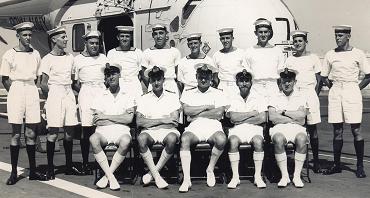
"HMS
Eagle, dated 28 August 1956, The
Helicopter Rescue Unit.
seated centre - Pete Ragley, Jim, and
Chief 'Duff Cooper'"
After an accident
in the mess, transferred to RNAS Gosport on 17
April 1952 for training on Sikorsky S51
helicopters. First posting was to HMS Vulture,
RNAS St Merryn, Cornwall, as a SAR (Search and
Rescue) pilot for 4 or 5 months.
On the 9 Nov 1953, he was loaned to the Royal
Australian Navy and served on HMAS Sydney in
the Korean War theatre on SAR. He flew out in
a Constellation, joined Sydney in Singapore,
and returned home at the end of hostilities
from Singapore to Stanstead in Essex in an
Avro York. While out in the Far East, he
travelled by boat from Kure, Japan to visit
Hiroshima.
After leave, posted to HMS Seahawk, RNAS
Culdrose in June 1954 as search & rescue
pilot. Following a quick conversion
course to Sikorsky S55's at HMS Daedalus, RNAS
Lee-on-Solent, he was posted to fleet
carrier HMS Eagle on 6 February 1956 as
Commanding Officer of the Search & Rescue
unit. During this time, Eagle took part in the
Suez Campaign, and Jim received two
Commendations. One, to the whole crew was from
the Commander-in-Chief for rescuing Lt. Lyn
Middleton (who
commanded carrier HMS Hermes in the 1982
Falklands War and later went on to become an
admiral). The second was a Mention in
Despatches for flying in and out of the War
Zone at Suez, taking in medical supplies and
bringing out the wounded. Jim lifted out Lyn
Middleton on a second occasion, and narrowly
missed doing so on a third. That was off the
south coast of Malta when the resident crew at
Halfar did the job.
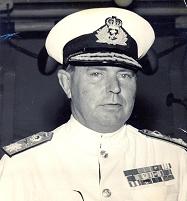 Rear Admiral Power, F.O.A.C. - "A Man we
all Admired" (Sir Manley, KCB, CBE,
DSO*, commanded 26th Destroyer Flotilla
which sank Japanese heavy cruiser Haguro
in May 1945, promoted Rear Admiral 1953,
Flag Officer Aircraft Carriers 1956-57)
Rear Admiral Power, F.O.A.C. - "A Man we
all Admired" (Sir Manley, KCB, CBE,
DSO*, commanded 26th Destroyer Flotilla
which sank Japanese heavy cruiser Haguro
in May 1945, promoted Rear Admiral 1953,
Flag Officer Aircraft Carriers 1956-57)
HMS
Eagle and rest of "our Carrier Air
Group"
(possibly Albion and Bulwark)
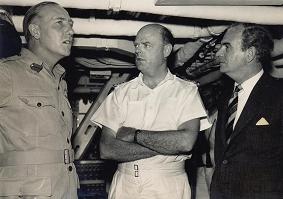
G.O.C. Cyprus and the Captain, The
Maclean of Maclean, (unidentified)
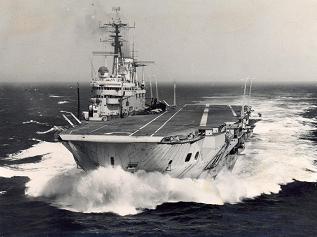 HMS Eagle - speed trials
HMS Eagle - speed trials
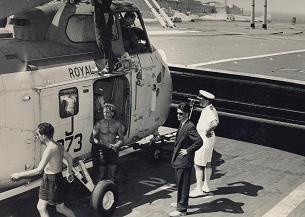 Jim
ranging a helo at Malta, Captain
Maclean on lift
Jim
ranging a helo at Malta, Captain
Maclean on lift
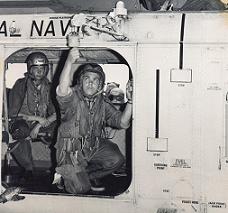 HMS Eagle,
dated 14 June 1956. Piloted by Jim
Summerlee, with crewmen Mitchell and
Hazel (testing winch) off Cyprus. Note
side arms.
HMS Eagle,
dated 14 June 1956. Piloted by Jim
Summerlee, with crewmen Mitchell and
Hazel (testing winch) off Cyprus. Note
side arms.

"How do you do? Shaggers & Sheepy
(Lamb)"
(two of Jim's oppos in the early 1950's
on HMS Vengeance. "Sheepy" was awarded a
second DSC at Suez)
and from
"Crises
Do Happen: the Royal Navy and
Operation Musketeer, Suez, 1956" by
Geoffrey Carter, Maritime Books, 2006
"Following
a Wyvern bombing attack on the fortified
Coastguard Station at Port Said during the
Suez campaign:
'Lt Cdr Bill Cowling, recognising that his
aircraft had been hit (by flak), climbed
to 1200 feet but had to throttle back.
Eagle having acknowledged his Mayday call,
Cowling ejected from his Wyvern some five
or six miles from Port Said. As he landed
in the sea, a Whirlwind helicopter, flown
by Lt Cdr Jim Summerlee, was nearby
transporting wounded soldIers back to the
carrier. Cowling was quickly hauled aboard
and, although he had to stand up for the
journey, was soon back aboard Eagle.'"
(page 31)
OTHER SOURCES
Apart
from a variety of internet sites, a number
of specific sources on the Royal Navy in
Operation Musketeer have been found. They
are listed in order of publication date:
Suez,
1956, Operation Musketeer by
Robert Jackson, 1980
Crises
Do Happen: the Royal Navy and
Operation Musketeer, Suez, 1956
by Geoffrey Carter, 2006
Suez, 1956: A Successful Naval
Operation Compromised by Inept
Political Leadership by Michael
H Coles, 2006, PDF download from
US Naval War College site
Operation Musketeer - the Suez
Canal Crisis of 1956: The
Stories and Photographs from
Those Who Were There, by Eric
Pegg, 2013
|
|
|
|
Recorded
in The London Gazette, issue 41172, 10th
September 1957
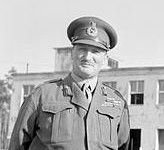
General
Keightley, C-in-C (Wikipedia)
The Ministry of Defence,
12th September, 1957
DESPATCH BY
GENERAL SIR CHARLES F. KEIGHTLEY, GCB., GBE.,
DSO.,
COMMANDER-IN-CHIEF, ALLIED FORCES
OPERATIONS IN
EGYPT—NOVEMBER to DECEMBER, 1956
The following despatch describes the operations
in the Eastern Mediterranean from 30th October,
1956, when orders were issued by Her Majesty's
Government to be prepared in certain
circumstances to initiate operations in Egypt
until 22nd December, 1956, when evacuation was
completed. I am forwarding certain detailed
recommendations on specific organisational
tactical and technical matters separately.
ONE
Background
On 11th August, 1956, in the appointment of
Commander-in-Chief of the British Middle East
Land Forces, I was informed that, in view of
Egypt's action in nationalising the Suez Canal,
Her Majesty's Government and the French
Government had decided to concentrate certain
forces in the Eastern Mediterranean in case
armed intervention should be necessary in order
to protect their interests and that in this
event I was to assume the appointment of Allied
Commander-in-Chief of all British and French
Forces engaged.
In my capacity as
Commander-in-Chief Middle East Land Forces I
had already been engaged in planning for
possible operations in the area but mainly in
the event of Britain being involved as a
result of her commitments through the
Anglo-Jordanian Alliance.
It was now necessary to consider
specifically what action should 'be taken
against Egypt if her seizure of the Canal
should result in hostilities.
The following forces were earmarked by the
British and French Governments should
operations prove to be necessary: —
BRITISH
Naval
Aircraft
Carrier Task Group
Support Forces Group, including Cruisers,
Darings, Destroyers and Frigates
Minesweeping Group
Amphibious Warfare Squadron
Land
16 Independent
Parachute Brigade Group (including 1, 2
& 3 Para)
3 Commando Brigade, Royal Marines (including
40, 42 & 45 Cdo)
10 Armoured Division
3 Infantry Division
Medium and
Light Bomber Force
Fighter/Ground Attack Force, shore-based and
carrier-borne
Reconnaissance and Transport and Helicopter
Forces
FRENCH
Naval
Aircraft Carrier
Task Group
Support Forces Group, including 1 Battleship,
Cruisers, Destroyers and Frigates.
Minesweeping Group
Land
10 Division
Aeroportee
7 Division Mecanique Rapide
Air
Fighter/Ground
Attack Force, shore-based and carrier-borne
Reconnaissance and Transport Forces
The following Commanders were nominated to draw
up plans and to assume command in the event of
operations :—
Vice-Admiral
D'Escadre P. Barjot - Deputy
Commander-in-Chief
Vice-Admiral M. Richmond, CB., DSO., OBE. -
Naval Task Force Commander (Succeeded by
Vice-Admiral D. F. Durnford-Slater, CB., on
24th October, 1956).
Contre-Amiral P. Lancelot - Deputy Naval Task
Force Commander
Lieutenant-General Sir Hugh Stockwell, KGB.,
KBE., DSO. - Land Task Force Commander
General de Division A. Beaufre - Deputy Land
Task Force Commander
Air Marshal D. H. F. Barnett, CB., CBE., DFC.
- Commander Air Task Force
General de Brigade R. Brohon - Deputy
Commander Air Task Force
I formed a small Allied Headquarters in London
and similarly Task Force Commanders built up
their Headquarters which were also located in
London.
Owing to the Forces concerned being located as
far apart as the United Kingdom, Malta, Cyprus,
France and Algiers, and my Headquarters being
split between London and Cyprus a great deal of
travelling was required by all Commanders.
Throughout August and September plans were made
to take action in Egypt if some crisis should
occur to demand our intervention. These plans
were necessarily flexible as it could not be
foreseen precisely in what circumstances it
might be necessary to intervene.
Whatever action was required by us would however
clearly require airborne and sea assault
operations and the British and French Airborne
Forces and Commandos were prepared and trained
for such action.
The main limitations to our operations were
caused by the following factors: —
1. Lack of
harbours or anchorages or landing craft
"hards" in Cyprus: thereby necessitating any
seaborne assault being launched from Malta,
which was over 900 miles away.
2. Shortage of airfields in Cyprus. At
the outset of the planning only Nicosia was in
operation and that was under reconstruction
and not working to full capacity. Akrotiri and
Tymbou were developed rapidly during September
and October.
3. Limited resources of landing craft
and air transport We had only a total of 18
LST's and 11 LCT's. We had an air lift for two
battalions but very limited air supply
resources.
TWO
Early in October I was instructed to recast our
current plans so that action could if necessary
be taken any time during the winter months.
This had wide repercussions.
Men could not be kept for long stretches at a
number of hours notice to move, and in view of
the prolonged period that the call up had lasted
it was especially desirable to send reservists,
who had been called up at very short notice, on
leave.
Certain vehicle ships had to be unloaded as some
of the vehicles had been loaded for as much as
three months and batteries and equipment were
deteriorating so much that they were unlikely to
be able to start on landing. In addition there
was a danger from petrol fumes in the loaded
ships.
A stockpile of supplies was built up in
Cyprus but even so owing to the limited port
resources the majority of ships for the
follow-up and supply for the assault troops must
come from the United Kingdom. This demanded
ships which it was quite impossible economically
to hold loaded for a long stretch being
requisitioned and sailed to the Eastern
Mediterranean.
Neutral shipping in and approaching the Suez
Canal would have to be diverted before any
operations could take place.
Up-to-date intelligence was required of Egyptian
preparations and land and air dispositions. This
would necessitate photographic reconnaissance
over the area of assault and the airfields.
Action would be necessary and was planned to
evacuate the British contractors working in the
Suez Base.
Weather would be deteriorating and emphasised
the time required to sail the assault landing
craft from the nearest harbour where they could
be held, at Malta, to Port Said.
The effect of these factors was to make a
requirement for a longer period between the
executive order to start operations being
received and the date it was possible to land on
the mainland of Egypt.
The period of notice which had been accepted for
the start of operations was 10 days, although in
the event we got little more than 10 hours.
Exercises
One of our greatest problems was to train and
exercise the troops and Headquarters involved
for the task which lay ahead, owing to the
immense dispersion of the forces, involved.
The forces in the United Kingdom were
concentrated on Salisbury Plain and at their
home stations and certain useful unit training
was carried out
Landing exercises were carried out with the
Commandos and 6th Royal Tank Regiment at Malta.
It was in the Command and control field and
especially with regard to Signal exercises where
we were most handicapped and it is a great
credit to all the Headquarters and Signal staffs
that in the event communications worked so well.
Early in October Task Force Commanders had
pressed for a Command Signal Exercise in
particular to exercise the Headquarters ship.
This exercise, called Exercise Boathook, was
agreed in October and planned to take place
early in November; in the end it never took
place.
Israeli
Mobilisation
During the last week in October intelligence
sources were reporting from Tel Aviv and
elsewhere increasingly strong indications of
Israeli mobilisation. As a result of these
reports certain precautions were taken as
regards the preparedness of our forces.
On October 29th Israel attacked across the Sinai
Peninsula.
THREE
Situation on 30th October
On 30th October I was informed that Her
Majesty's Government were issuing a requirement
to Israel and Egypt : —
(a) to cease
hostilities by land, sea and air;
(b) to withdraw contestant troops ten miles
from the Suez Canal;
(c) to allow occupation by Anglo-French Forces
of Port Said, Ismailia and Suez.
I was to be prepared to take action on 31st
October in the event of this requirement not
being met by either country.
It was therefore clear that instead of 10 days
interval between the executive order and the
start of operations I was liable to get about 10
hours, and our operations might well be quite
different to those for which we had planned.
There was much to be done.
Of the many immediate steps to be taken the most
important were:—
(a) To complete
the preparedness of the Allied Air Force.
(b) To embark and sail the British Assault
Force from Malta and the French Assault Force
from the Westbrn Mediterranean.
(c) To embark and sail the immediate follow-up
forces from Malta, the Western Mediterranean
and the United Kingdom.
(d) To open up all Command Signal nets between
my Allied Force Headquarters, Task Force
Headquarters and formations.
Allied Forces were then located as follows: —
NAVAL FORCES
British and French Naval Forces were then in the
general area of the Central Mediterranean.
LAND FORCES
British
16 Independent
Parachute Brigade in Cyprus.
3 Commando Brigade and 6 Royal Tanks in Malta.
10 Armoured Division in Libya.
3 Infantry Division in the United Kingdom.
French
10 Division
Aeroportee partly in Cyprus.
7 Division Mecanique Rapide in Algeria.
AIR FORCES
British
Bomber force in
Cyprus and Malta.
3 Ground attack squadrons in Cyprus.
French
2 Ground attack
squadrons in Cyprus.
FOUR
The Plan of Operations
At 0430 hours 31st October I was informed that
the Israeli Government had agreed the
requirement and that Egypt had refused.
My object was defined as follows: —
(i) To
bring about a cessation of hostilities between
Israel and Egyptian forces.
(ii) To interpose my forces between those of
Israel and Egypt.
(iii) To occupy Port Said, Ismailia and Suez.
The agreement to our requirements by the
Israelis and the refusal by the Egyptians meant
that we were now involved in operations against
the Egyptians but with limited objectives.
My instructions were that air operations against
the Egyptians would start on 31st October.
My estimate of the Egyptian strength at this
time was as follows, not taking into account
such forces as were known to have been engaged
in the Sinai Peninsula: —
Egyptian Air
Force
80 MIG 15's
45 IL 28 bombers
25 Meteors
57 Vampires
200 trainers, communication and transport
Egyptian Army
75.000 Infantry
300 tanks which included over 150 modern
Russian tanks (JS 3's, T 34's and T 85's).
An unknown number of self-propelted anti-tank
guns, including the modern Russian SU 100's.
A considerable number of anti-aircraft guns and
a modern radar organisation.
My main concern was naturally that of speed.
Certain parts of the previous plans could fit in
with the operation which I was now required to
carry out; certain of them could not.
The limiting factor was clearly the Commando and
armour located at Malta. As a result of previous
preparedness and excellent work by all officers
and men they were embarked on the night 30/31st
October and directed to sail at full speed for
Port Said, a distance of 936 miles by the
shortest route. At the maximum speed of the
landing craft this trip must take 6 days.
The aircraft carriers and HQ ships had been
assembling in the Central Mediterranean for
Exercise Boathook. This was in some ways an
advantage and in some ways a disadvantage.
Although it resulted in ships being reasonably
concentrated they could not be briefed
personally or easily for the operations in hand.
The Royal Air Force were the most easily
prepared for action. It was clearly necessary to
eliminate the threat of Egyptian air effort from
being able to engage our landing craft as they
sailed from Malta along the Egyptian coast or
our air transports from Cyprus as they
approached their dropping zones. Further, any
action by the IL.28 bombers against our
overcrowded airfields in Cyprus would have done
damage out of all proportion to the effort
involved.
Although the effectiveness of the Egyptian Air
Force was never overestimated, they had been in
action against the Israeli forces and they had
foreign technicians who were certainly capable
of carrying out missions on the Korean pattern.
So my first objective was the Egyjptian Air
Force.
The plan for this was a combination of high
level bombing with contact and delay action
bombs to damage runways and discourage aircraft
from taking off. This to be followed by daylight
ground attacks.
It was estimated this would take 48 hours to
complete.
The next problem was when to use our airborne
forces.
We had a limited airborne effort but in
particular our air supply lift and air supply
resources were very restricted. The offensive
power we had against the Egyptian anti-aircraft
guns was from the Fleet Air Arm and fighters
from Cyprus, the time over target of the latter
being limited to ten to fifteen minutes.
My final objective at this stage it may be
remembered was Suez. My problem was therefore to
prevent the Egyptians moving any of their
armoured forces, which were concentrated in
reserve, to the Canal Zone and especially on to
the Causeway, that narrow strip of sand at
places only a few hundred yards wide, on which
the road runs from Port Said to Ismailia. Here
even a few tanks might have caused a physical
block which would have taken a very considerable
time to clear. We hoped to do this by keeping
them uncertain until the last moment whether our
main attack was to be at Port Said or
Alexandria. This, in fact, we succeeded in
doing.
It was therefore decided to employ the airborne
forces early enough to facilitate a quick run
through of the armour but to avoid using them
piecemeal whereby they might become immobilised.
Weather was also a factor to be reckoned with.
At this time of year weather can deteriorate
very suddenly and very seriously.
Apart from the start of air operations, the
speed of operations was dictated solely by local
factors. It was estimated that we would land our
assault forces from Malta by November 6th, have
seized Ismailia by November 8th and Suez by
November 11th. That would have completed the
whole operation in 12 days from the start of air
operations.
FIVE
The Operation
At 1615 hours GMT on 31st October, 1956, Valiant
and Canberra bombers under the command of Air
Marshal Barnett began their attacks on Egyptian
airfields at Almaza and Inchas near Cairo and at
Abu Suier and Kabrit in the Canal Zone. These
attacks were continued with the aid of flares
during the early part of the night and
encountered a certain amount of anti-aircraft
fire but no night fighters.
We had an anxious moment when I was instructed,
after the aircraft had taken off on their first
mission which included Cairo West Airfield, not
to attack that airfield, since information had
been received that American Nationals were being
evacuated to Alexandria and were using the road
close to the airfield. Since Cairo West was a
main bomber base for the Russian made IL 28's
its sudden reprieve was a matter of concern.
However, in the event, the Egyptians only used
it to remove their IL 28's to Luxor.
I was also instructed to be prepared to attack
Cairo Radio later after issuing warnings so as
to avoid civilian casualties.
During the night HMS Newfoundland encountered
the Egyptian Frigate Domyat in the Red Sea and
sank her after she had failed to reply to a
signal: 68 survivors were picked up.
From daylight onwards Allied shore-based and
carrier aircraft carried out highly successful
attacks on aircraft on Egyptian airfields while
French naval aircraft set fire to a
Russian-built destroyer off Alexandria.
Two attempts were made to sink the old LST Akka
which had been identified as a prepared
blockship. Anchored in shallow water in Lake
Timsah she was well placed for towing into the
narrow channel at the southern end of the lake.
Unfortunately the attacks were only partially
successful and before the ship could be sunk she
had been towed in a sinking condition to her
blocking position. In view of the subsequent
orgy of sinking carried out by the Egyptians the
relative importance of the Akka assumed far less
significance than seemed likely at the time.
By the end of the day the Egyptian Air Force had
been severely treated: a large number of
aircraft had been destroyed or damaged on the
ground and very few appear to have been
airborne. Only one of our aircraft had been
attacked in the air and suffered slight damage,
while others had incurred minor damage from
anti-aircraft fire.
During the night, bomber attacks from Cyprus and
Malta were kept up against Egyptian airfields
followed up by ground attacks by naval and shore
based aircraft from first light onwards on 2nd
November. Later in the day these attacks were
made on Huckstep Camp, which contained many
armoured fighting vehicles and large quantities
of military transport, and on Almaza Barracks,
also a military concentration area.
Cairo Radio was then attacked during the morning
by a force of Canberras with top cover provided
by French fighters. Bombs were dropped on the
Radio Masts of the transmitter station which are
some 16 miles from the town, after warnings had
been given by the Voice of Britain Radio in
Cyprus. After the attack the short wave
transmitters of Cairo Radio went off the air and
the Voice of Britain operated on the Cairo
wavelength. This attack was only partially
successful but by the time the damage had been
repaired and the short wave transmissions of
Cairo Radio had been fully resumed a cease fire
had come into effect.
During the day air reconnaissance disclosed the
first signs that the Egyptians were carrying out
extensive blocking of the Canal. Ships were seen
sunk across the entrance to Port Said and
another ship was seen sunk near El Firdan.
By the end of 2nd November it was evident that
the task of neutralising the Egyptian Air Force
was all but complete. A number of IL 28's still
remained untouched on Luxor airfield which was
attacked during the night 2-3rd November and on
4th November.
During 3rd November the bulk of the air effort
was switched from airfields to other military
targets. Huckstep Camp and Almaza Barracks were
again attacked, as was the marshalling yard at
Ismailia with the object of slowing up any
reinforcement of Port Said by rail. The above
utilised a small part only of our available air
effort, but lack of suitable targets in areas
away from the civilian population, whose safety
was from the outset one of our primary concerns,
materially restricted their activities. The use
of the bomber was in fact to be discontinued and
their last attack was an attempted raid on the
guns and submarine base at Agami Island off
Alexandria on the night of 3-4th November. The
attack was intended primarily to attract
attention away from Port Said.
The main air effort from now onwards was
directed against the very heavy military
movement in the Canal area. Armed reconnaissance
missions found much military transport and
considerable numbers of tanks. These were
heavily intermixed with civilian vehicles of all
descriptions and many military targets had to be
discarded by pilots for this reason.
It is interesting to record the behaviour of all
these vehicles on the arrival of our aircraft.
In general military crews abandoned their
vehicles, whereas the civilian traffic proceeded
unperturbed. This speaks highly for the
integrity of our aircrew and the complete trust
in our frequently broadcast intentions of
attacking only military objectives. Similar
behaviour had been reported during our air
attacks on airfields, when pilots reported that
the only military activity seen was from
antiaircraft guns but that numbers of spectators
watched their activities from the perimeter of
the landing ground. The same undisturbed public
interest was later to be reported from Port Said
in the course of the assault.
On the 3rd and 4th November air attacks were
directed at armoured concentrations and military
movement on the roads. Photographic
reconnaissance of the Port Said beaches and
defences was completed. This showed that the
Egyptians were prepared to defend the town and
the beaches and that there were considerable
numbers of anti-aircraft guns in position and
some dug-in tanks. Mines were also seen on the
beaches. Nasser had already announced his
intention of concentrating to fight the Allies
and there was every indication that preparations
were being made accordingly.
As a result of our latest information on
Egyptian defences and dispositions, the weather
forecast and the progress of the assault force
from Malta, I confirmed with the Task Force
Commanders that we should carry out an airborne
assault on the Port Said area on the 5th
November.
It was accordingly planned to drop at first
light on 5th November one British Parachute
Battalion on Gamil airfield, West of Port Said,
and one French Parachute Regiment in two
echelons, firstly on the Southern exits from
Port Said and secondly on the Southern end of
Port Fuad. The British force was to advance into
the town and occupy it if resistance was slight
but if unable to do so it would wait for the
seaborne assault on the following day. To this
end Allied shore based and carrier aircraft
attacked all military road movement and
concentrations of tanks and vehicles, as well as
coast defences and anti-aircraft gun sites
around Port Said, the greatest care being taken
throughout to avoid damage to civilian property.
During 4th November Lieutenant-General Stockwell
and Air Marshal Barnett joined Vice-Admiral
Durnford-Slater in H.M.S. Tyne and sailed from
Cyprus together with the seaborne support troops
for both the British and French parachute
operations.
The sea convoys from Malta and Algiers were also
converging on Port Said, the weather was good.
Anxiety was caused by the activities of the U.S.
Sixth Fleet which, since 31st October, had been
moved to and stationed in the same operating
areas as our own carriers, in order to provide
protection for the evacuation of U.S. nationals
from Alexandria and the Levant. Despite the very
real difficulties created by this situation and
the great inconvenience experienced by our
forces, thanks to the good sense of the two
naval commanders both were able to carry out
their functions efficiently and without
incident. The U.S. Fleet withdrew from the area
during the night 4/5th November.
During the day aircraft from the British carrier
force attacked three enemy E-boats heading for
Alexandria. Two were sunk and the third, though
damaged, was allowed to pick up survivors from
the other boats and was seen making its way to
harbour.
Two further problems were to arise before the
actual assault. By 4th November I had been
informed that I could no longer count on the
arrival of 10 Armoured Division from Libya. This
formation was therefore removed from the Order
of Battle. I was offered instead 3 Infantry
Brigade which had come out from England to
replace 10 Armoured Division in Libya and was
then in Malta. General Stockwell considered he
did not require any more infantry but might
later need additional armoured units. Two such
regiments were then earmarked to come from the
United Kingdom.
At 2015 hours GMT on 4th November I was asked to
state, in the event of a postponement of the
airborne assault for 24 hours being ordered for
political reasons, what was the latest time by
which a decision must be made. In reply I gave
the hour as 2300 hours GMT and added that any
such postponement would have most serious
consequences and must be avoided at all costs.
Admiral Barjot fully supported my views. It was
accordingly agreed there should be no
postponement and the stage was now set for the
assault.
SIX
The Airborne
Assault—5th November
The morning of 5th November broke clear, with a
light wind, and for some hours beforehand Allied
paratroopers had been loading and emplaning in
their aircraft on Nicosia and Tymbou airfields.
At 0820 hours GMT 3 Parachute Battalion Group
and 16 Parachute Brigade Tactical HQ, some 600
strong, began their jump on to Gamil Airfield to
the West of the town. A few minutes later 500
men from the 2 Regiment Parachutistes Coloniaux
(2RPC) dropped near the water works to the South
of Port Said.
Anti-aircraft fire was encountered and was dealt
with by anti-flak patrols of shore based
aircraft. Although nine transport aircraft were
hit there were no casualties and all returned
safely to their base.
Both landings were successful although they were
met with considerable fire from machine guns,
mortars and anti-aircraft guns used in a ground
role and from self-propelled guns, the Russian
self-propelled SU 100's. The French quickly
secured intact their two important objectives,
the water works and the main road and rail
bridge over the Interior Basin. The Egyptians
succeeded in destroying the less important
pontoon bridge. The Water works were of
particular value for, although we had made
provision to supply the town by water tanker, in
that event strict water rationing would have
been necessary.
By 0900 hours the airfield was securely in our
hands and shortly afterwards a helicopter was
able to land to take off casualties. 3 Parachute
Battalion then advanced eastwards towards Port
Said town.
A particular centre of resistance which for a
time held up the Eastward advance of the British
parachute force was the Coastguard Barracks,
which were demolished by an extremely accurate
air strike by Wyverns and Sea Hawks of the Fleet
Air Arm without damage to surrounding buildings.
Meanwhile the Russian self-propelled anti-tank
guns (SU 100's) which had been dug in along the
foreshore left their emplacements and turned to
meet the threat from Gamil.
These guns were most skilfully handled and
caused us considerable trouble, the fighting
here was hard and the Egyptians made good use of
their dug positions which were often difficult
to locate. I warned General Stockwell that
unless the parachute operation achieved complete
success these armoured self-propelled guns might
have to be neutralised by destroyer fire before
the seaborne landing was made next day.
Egyptian resistance was very stubborn throughout
the morning. It centred mainly round the SU
100's which were being used as mobile centres of
resistance. By degrees the 3 Parachute Battalion
overcame these positions and under continuous
fire made further progress towards the town.
One of the features of this operation was the
excellent support provided by the aircraft from
the Carrier Force. Continuous missions were
flown throughout the day and there was always a
"cab rank" of British and French aircraft
overhead waiting to be called down on targets by
the troops on the ground. Such targets as
presented themselves were for the most part on
the outskirts of the town. Shore based fighters
and ground attack aircraft meanwhile made
certain that no revival was possible from the
Egyptian Air Force and that no reinforcements
reached Port Said.
At 1345 hours GMT a second drop of 100 men of 3
Parachute Battalion Group with vehicles, heavy
equipment and re-supply was made at Gamil. Some
460 French parachutists of 2 Regiment
Parachutistes Coloniaux dropped on the Southern
outskirts of Port Fuad: here for a time
resistance was stubborn and some 60 of the enemy
were killed, thereafter opposition at Port Fuad
collapsed. Egyptian military vehicles made for
the ferry across the harbour and were attacked
with great effect from the air.
At 1500 hours GMT the local Egyptian Commander
in Port Fuad contacted the Commanding Officer of
2 Regiment Parachutistes Coloniaux to discuss
surrender terms on behalf of the Governor and
Military Commander of Port Said. The latter was
referred to Brigadier M. A. H. Butler, DSO.,
MC., Commander of 16 Parachute Brigade, who was
in control of the whole airborne assault and who
had dropped at Gamil. Half an hour later at 1530
hours GMT a Cease Fire was ordered by the
Commander in Port Said while negotiations were
in progress. Surrender terms were agreed and the
Egyptian forces began to lay down their arms
while their police were assisting under orders.
Subsequently, however, the proposed terms were
rejected by the Egyptians, and operations were
resumed at 2030 hours GMT. It was later
confirmed that the matter had been referred to
Cairo whence orders had been issued for the
fight to be continued. Although we had cut all
possible telephone communications, there were
wireless sets and an underwater cable which we
had not the resources to destroy in time. On the
resumption of operations, the Garrison and
populace were encouraged to resist by
loudspeaker vans which toured the town
announcing that Russian help was on the way,
that London and Paris had been bombed and that
the Third World War had started. At the same
time arms were distributed to civilians, some
from lorries and some from piles dumped in the
streets. These arms appear to have been handed
out to all civilians, many of whom used them
indiscriminately, causing casualties to both
sides.
Up to this stage there had been very little
fighting in built up areas and hence few
casualties had been caused to civilians or
damage to private property.
In Port Fuad 2 Regiment Parachutistes Coloniaux
met little further resistance and completed the
capture of the area during the hours of
darkness. 3 Parachute Battalion were however up
against much stiffer resistance. On the narrow
strip of land between the sea and Lake Mansala
they came under fire from mortars, including the
Russian multi-barrel type, from Arab Town.
It was now clear that Port Said could not be
captured and cleared by the Parachute Force
alone and that the seaborne force would have to
make an opposed landing the next morning.
The decision to launch a comparatively small
airborne force without preliminary air bombing
or naval bombardment against a large town, whose
defence was numerically nearly three times as
strong and was supported by armour, had proved a
justifiable risk. Port Fuad, the water works and
the most important bridge to the South had been
captured intact and a small but serviceable
airfield was in our hands. All this had been
achieved with few casualties to our own troops
and negligible casualties to civilians or damage
to property. The subsequent tribulations which
were suffered by Port Said were entirely due to
the local Commander being overruled and
instructed to continue the battle.
SEVEN
The Seaborne
Assault—6th November
The heavy air and naval pre-assault fire
plan had been drastically reduced and I had
issued precise instructions that supporting fire
was to be confined strictly to known enemy
defences and to those which engaged our assault.
Air bombing was prohibited and heavy naval guns
were banned.
We thus maintained our policy of accepting risks
to our own forces in order to minimise Egyptian
civilian casualties and damage to their
property. The results bear witness to the
effectiveness of these measures and their strict
observance by the forces engaged, despite the
distorted and exaggerated reports broadcast from
Cairo and circulated throughout the world.
For 45 minutes before the landing some 3000
yards of the beach were subjected to covering
fire from destroyers. The object of this fire,
which was extremely accurate, was to neutralise
known enemy positions which had been dug amongst
the bathing huts on the foreshore. That it
achieved its purpose was evident from the
quantity of ammunition and equipment which was
later found abandoned on the beaches. Although
this fire was comparatively light and was only
used against known positions or SP guns which
actively fired, it achieved the result of
enabling our forces to land without suffering
the casualties usually expected in an assault
against a defended and mined coast.
It was not found necessary to engage the coast
defence guns on the breakwater which were silent
and had evidently been neutralised after
previously being attacked from the air.
Fortunately also the French Parachute force had
completed the occupation of Port Fuad during the
night so that the French seaborne landing on
this flank required no supporting fire.
Further support for the assault on Port Said was
provided by an air strike on the beaches lasting
for 10 minutes immediately before the start of
the naval gunfire: the beaches were again
engaged in a low level attack along their whole
length after the naval fire had stopped and just
before the leading troops reached the shore.
Preceded by minesweepers the assault force
reached its destination exactly on time after
the sea passage from Malta of over 900 miles
having taken 6 days. At 0450 hours GMT the
leading waves of 40 and 42 Royal Marine
Commandos came ashore and across the beaches in
LVTs (Landing Vehicle Tracked) before
disembarking. This obviated what otherwise would
have been an excessively long wade on the
gradually shelving beach, and an exposed run
across the broad beaches before reaching cover.
One squadron of the 6th Royal Tank Regiment was
waterproofed and waded ashore from LCTs (Landing
Craft Tanks) which touched down in 4 1/2 feet of
water.
At the same time the French Assault Force
consisting of 1st Regiment Etranger
Parachutistes and three Naval Commandos,
supported by a squadron of light tanks, was
making an unopposed landing on the beaches of
Port Fuad.
As the Royal Marine Commandos passed through the
beach huts, which were by then on fire and
amongst which quantities of abandoned ammunition
were exploding, they came under small arms fire
from buildings along the sea front and one SU
100 on their right flank opened fire on one of
the supporting destroyers. The destroyer
returned the fire and as a result conflagration
started in the shanty town in the immediate
neighbourhood of the SU 100; fanned by a stiff
breeze a large area of this collection of shacks
was burnt out.
Luckily an area free of the Russian mines placed
along the beaches was found at the point of
assault.
The objectives of 42 Commando supported by the
tank squadron less one troop, was to get through
Port Said as quickly as possible to the area of
Golf Course Camp and thereby seal off the
Southern exits of the town, while 40 Commando
with one troop of tanks was to clear the
vicinity of the harbour in order to enable craft
to enter without coming under fire.
42 Commando met considerable resistance in the
area of the Governorate where 100 to 150
Egyptian Infantry debouched from buildings South
and West of the Square. They were engaged by
supporting tanks, but as they continued to hold
out in a block of buildings which lay across the
main axis of advance of 42 Commando, an air
strike was called down at 0700 hours GMT.
Immediately after this the advance was resumed
with the Commandos travelling in their
unarmoured open LVTs escorted by tanks. They
moved rapidly down the Rue Mahomet Ali coming
under fire from side streets with grenades being
thrown down from balconies overhead.
The Commandos replied with their personal
weapons - while the tanks knocked out anti-tank
guns halfway down the street and overran a
further three guns as they emerged into the open
South of the heavily built up area.
The Commandos suffered some casualties at this
stage in their vehicles and while subsequently
clearing the houses on either side of the
street.
Meanwhile 40 Commando was carrying out a
deliberate clearance of the houses along the
Quai Sultan Hussein bordering the harbour. A
considerable number of Egyptian infantry were
seen and engaged to the West of this axis and
strong opposition developed amongst the
warehouses behind Navy House.
At 0540 hours GMT the Commanding Officer of 45
Commando took off from HMS Ocean in a helicopter
to reconnoitre the landing zone for his unit. In
the smoke and haze the pilot lost his way and
landed temporarily in an Egyptian held football
stadium where the party came under fire. Quickly
realising his mistake he re-embarked his
passengers and made good his escape in spite of
a considerable number of bullet holes in his
machine.
45 Commando were landed using 22 helicopters
from HMS Ocean and Theseus and 90 minutes later
400 men and 23 tons of stores were ashore near
the Casino Pier without further incident. This
was the first occasion on which such an
operation had been carried out.
The remainder of 6 Royal Tank Regiment
disembarked at the Fishing Harbour later in the
morning. One squadron was placed in support of
45 Commando who had the task of clearing the
town between the axes of the two leading
Commandos: the other squadron by-passed the
opposition with which 40 Commando was dealing
and finally joined up with the French
parachutists well South of the town near the
bridges over the Interior Basin.
By 0730 hours GMT 42 Commando and its supporting
tanks had taken up positions in the area of the
Gas Works and Golf Course Camp South of the town
from which they engaged Egyptian infantry near
the Prison. These appeared to be forming up for
a counterattack and an air strike was called
down on them at 0900 hours whereupon they
rapidly dispersed.
From then onwards until 1200 hours GMT 42
Commando engaged Egyptian infantry trying to
cross their axis from East to West evidently
seeking sanctuary in the rabbit warren of Arab
Town. This Westward move was also due to
pressure from 45 Commando who were slowly
clearing the middle of Port Said.
Like all street fighting the clearing of Port
Said was a slow process made more difficult by
the fact that most of the regular Egyptian
troops had by then discarded their uniforms for
"gallabiyahs", and were indistinguishable from
civilians, many of whom were armed.
Streets had to be cleared house by house and
sometimes room by room. This took time and
required a considerable expenditure of small
arms ammunition and grenades. Failure to observe
the normal street fighting drill and the wish of
all ranks to get through Port Said as quickly as
possible led in some cases to avoidable
casualties to our own troops. It is a tribute to
their patience and forbearanoe that so little
damage was done to Port Said.
At 0900 hours GMT Lieutenant-General Stockwell
reported that, with the other Task Force
Commanders and General Beaufre, he was going
ashore to try to secure the unconditional
surrender otf Port Said. Negotiations were in
(progress through the Italian Consul and a
rendezvous had been arranged at the Consulate.
Lieutenant-General Stockwell and his party
sailed into the harbour in a motor launch as far
as the Canal Company building where they were
fired on from the direction of Navy House. Going
about they landed near the Casino Palace Hotel
and proceeded to the Consulate. The Egyptian
Commander however failed to come to the
rendezvous and as a result fighting continued
throughout the day.
By 1015 hours GMT a tough battle was taking
place in Port Said but the situation was
gradually being brought under control. British
and French forces had linked up at the Water
Works and the advance Southward was being
organised.
I was particularly anxious to secure as much of
the Causeway running South from Port Said as
quickly as possible, mainly in order to prevent
our break-out from the Causeway from being
blocked by the Egyptians but also to enable Port
Said to be used for unloading men and material
without interference or the requirement of a lot
of troops to secure it.
In Port Said the last area of resistance centred
round Navy House where tanks supporting 40
Commando used their guns to blow in the doors of
warehouses from which Egyptian fire was still
coming.
Finally, just before dusk an air attack was
called down on Navy House itself which still
held out. This building was engaged and our
troops occupied the area. All organised
resistance now ceased, 3 Parachute Battalion had
also closed up to the edge of Arab Town and the
Commandos bad linked up with the French South of
the town. Sporadic sniping however continued
throughout the night.
At 1700 hours GMT orders were received
from London that a United Nations Force would
take over from us and that a Cease Fire was to
take effect 2359 hours GMT, and that no further
move of forces would take place after that hour.
Orders were therefore issued to the leading
troops to halt at midnight by which time the
leading Allied Forces had reached El Cap, some
23 miles South of Port Said.
EIGHT
The Occupation
of Port Said
Early the next morning I flew into Gamil
airfield and joined General Stockwell there. We
then toured the town together in a Land Rover
which enabled me to get a first hand impression
of the situation in Port Said and the fighting.
The Egyptian Garrison had consisted of three
regular battalions supported by Russian
self-propelled anti-tank guns (SU 100's) and a
considerable number of anti-aircraft guns which
had been used in a ground role after the
parachute drop. The Garrison had been swollen by
a last minute influx from Sinai and there were
some 4,500 Egyptian regular troops in the area.
Arms and ammunition, mainly of Soviet
manufacture, had been supplied on a lavish scale
and there had been a widespread distribution to
civilians of all ages. The scale of this can be
judged from the fact that on 8th November 45
Commando recovered fifty-seven 3-ton truck loads
off arms and ammunition from the area round Arab
Town. This material was mainly surrendered by
Egyptians in civilian clothes.
British casualties had amounted to 16 killed and
96 wounded, while the French had had 10 killed
and 33 wounded. The value of helicopters for
evacuating fthe wounded to the aircraft carriers
was amply demonstrated. The French had convened
a large liner as a hospital ship.
The Egyptian casualties were much more difficult
to assess at the time since the civilian
administration had broken down and no records of
dead or wounded were available. Neither was it
possible to distinguish between military
casualties who had abandoned their uniforms, and
civilians, who were killed or wounded with arms
in their hands.
The damage to property was mainly confined to
buildings along the sea front, the burnt out
portion of shanty town, the block near the
Governorate and Navy Housb, both of which had
been attacked from the air with rockets. Damage
to the main town was remarkably slight.
The subject of Egyptian casualties and damage to
property has since been thoroughly investigated,
first by Sir Walter Monckton and then by Sir
Edwin Herbert, whose findings have been
published in a Government White Paper.
The situation in Port Said on November 8th was
then as follows:
Tactical Headquarters of the Joint Task Force
was in HMS Tyne moored alongside the Western
breakwater. 3 Commando Brigade together with 6
Royal Tank Regiment and 3 Field Squadron RE were
engaged in clearing up the Northern part of the
town. Port Fuad was occupied by the French. One
battalion of 16 Parachute Brigade was on Gamil
Airfield, the French Parachute battalion round
the water works, and a British Parachute
battalion with a French element was at El Cap.
During the day a clash took place here, either
because the local Egyptian troops were unaware
of the Cease Fire or as an act of deliberate
provocation.
From now onwards great efforts were made to
restore the administation of Port Said to
normal. The Egyptian administration was
bolstered up by our Civil Affairs Officers, food
distribution was organised, public utilities
such as sewage and electric light were quickly
repaired and the streets cleaned up. Fortunately
the water works were intact, but a careful watch
was kept on the level of the Sweetwater (or
Ismailia) Canal in case the Egyptian
Army chose to restrict the flow of water to Port
Said. Arrangements were also made to accept a
hospital train from Cairo whose despatch was
organised through United Nations channels.
High priority was given to salvage operations
and teams immediately started to inspect the
wrecks sunk by the Egyptians. There were 21 of
these in the harbour, far more than air
photographs had disclosed since many of them
were completely submerged. Blocking of the
harbour had been catered for in the planning and
two salvage ships, an ocean tug and four harbour
tugs together with the necessary Clearance
Diving Teams and HMS Dalrymple (wreck dispersal
and survey vessel) had been included in the
assault convoy. The two salvage vessels entered
harbour on 7th November and by the 9th November
a channel had been marked through the
blockships. Further salvage vessels continued to
arrive over the next week, but it was not until
12th November that the first LST was able to
pass through the blockships and berth in the
inner harbour. Search for obstructions was
extended down to El Cap while considerable
progress was made in actual salvage work and a
base was established on shore by the time the
main salvage force arrived.
On 9th November I was instructed that the policy
of Her Majesty's Government and the French
Government was to retain our hold in Port Said
until the United Nations Force was established
there and that we should do so in sufficient
strength to insure against a breach of the Cease
Fire.
The Allied Forces were to be redeployed as
follows:—
Naval Forces
Two British and
one French Carrier to remain on station in the
Eastern Mediterranean.
Ships for picket duties were to take station
off Cyprus.
Cyprus
A minesweeping
force, salvage and clearance ships would
remain until the Canal and its approaches were
clear, a Red Sea element being based on Aden.
Land Forces
In Port Said the
build-up of 3 Infantry Division, less 1 Guards
Brigade, was to be continued until completed.
The French were to provide the equivalent of
the one Brigade Group in Port Fuad.
16 Parachute Brigade to be withdrawn to the
United Kingdom, less one battalion group in
Cyprus.
3 Commando Brigade was to return to Malta.
3 Infantry Brigade from Malta and 1 Guards
Brigade from the United Kingdom to reinforce
Cyprus.
Air Forces
Of the bomber
force previously available 20 Valiants and 24
Canberras were to be held in the United
Kingdom at varying degrees of readiness. All
shore based aircraft in the Mediterranean were
to remain in position.
During the next few days the above plan was
modified to the extent of retaining the
personnel of 1 Guards Brigade and most of the
artillery of 3 Infantry Division in the United
Kingdom ready to fly out if required, while
their vehicles and equipment were held already
loaded at Malta. Other units of the build up,
mostly administration, were held in the United
Kingdom ready to be despatched by air or sea
should hostilities recommence. This was
obviously only a temporary expedient until the
situation became clearer.
Plans were also formulated to deal either with a
renewal of hostilities by Egypt or an Allied
evacuation. In the former case I intended to
break out down the causeway and capture Ismailia
and the airfield at Abu Sueir as a first step.
NINE
The United
Nations Emergency Force
On 13th November a team of United Nations
Observers who had sailed from Haifa were
disembarked at Port Said and moved South through
our forward positions at El Cap. United Nations
Liaison Officers were also attached to Allied
Force Headquarters and to 2 Corps Headquarters.
Three days later the leading elements of the
United Nations Emergency Force (UNEF) arrived by
air at Abu Sueir and shortly afterwards I was
informed that it had been agreed to station one
infantry company of this force in Port Said.
This company of Norwegians arrived by train on
21 November and was received with noisy
demonstrations by the inhabitants. Early the
next morning I was informed that as a result of
the arrival of the United Nations Force, one
British battalion and one third of the French
occupation force would be withdrawn. On 25
November General Burns met Lieutenant General
Stockwell and myself in Port Said and we agreed
to accept further United Nations troops in Port
Said and that a company should be established
between the Allies and the Egyptians at El Cap.
With the arrival of the United Nations Emergency
Force it now seemed that hostilities by either
side were out of the question and I therefore
informed the Chiefs of Staff that I could make
certain reductions in the Allied sea, land and
air forces and still retain a balanced force
capable of dealing with any likely eventuality.
From the morale aspect there was now every
reason for sending as many troops as possible,
particularly reservists, home for Cforistmas.
The next day I was officially informed that Her
Majesty's Government bad agreed to the
withdrawal of Allied units from Port Said as the
United Nations Emergency Force became effective;
I was therefore to plan on this basis although
the question of dates had not yet been settled;
my plans need no longer provide for a break out
towards Ismailia, but only at preventing the
Egyptians from moving troops into Port Said
until the latest practical time before our final
embarkation.
From then onwards our thoughts were entirely
concentrated on evacuation which in itself
raised many problems, the biggest being the fate
of the Allied Salvage Fleet.
TEN
The Evacuation
The plan for the evacuation had to take the
following factors into consideration: —
(i)
The minimum period for the operation was 14
days although the final date of embarkation
had not been settled and the period might be
prolonged by as much as 4 days.
(ii)
Egyptian troops were to be prevented from
entering Port Said until the Allied evacuation
was complete.
(iii)
Internal security would remain a commitment to
the end.
(iv) A
balanced force had to be maintained to meet
any emergency.
(v)
French and British withdrawal plans had to be
synchronised, particularly as regards shipping
arrangements.
(vi)
The safety of our own troops had to be secured
during the final stages of embarkation.
Some indication of the task can be judged from
the number of men, vehicles and quantity of
stores which were ashore on 1 December:—
|
British
|
French |
| Men |
13,500 |
8,500 |
| Vehicles
|
2,200 |
2,200
(including
trailers and motor
cycles) |
| Stores
(in tons) |
6,000 |
4,000 |
In addition to which a large number of British
personnel and Allied refugees had to be
evacuated.
The plan was phased so that on the final day of
embarkation the remaining British element would
consist of 19 Infantry Brigade made up of 1
Royal Scots, 1 West Yorks and one squadron 6
Royal Tank Regiment The French element would
consist of 1,500 men, and 200 vehicles including
one squadron of light tanks.
By 30 November a Danish Company had relieved 1
West Yorks at El Cap and was installed between
Allied and Egyptian positions, facing outwards,
an unusual military posture from which they were
relieved a few days later by a company of Indian
infantry. In Port Said a Jugoslav battalion had
disembarked and passed through our lines on
their way Southward and soon afterwards further
Danish, Swedish and Colombian contingents
arrived to swell the size of the United Nations
Emergency Force Garrison. These units cooperated
with British troops and Egyptian police in
maintaining law and order.
During the whole period of occupation the
Egyptians did their best to provoke incidents in
Port Said. A campaign of intimidation was
carried out to prevent Egyptians and foreign
nationals from co-operating with the Allied
authorities, shopkeepers were forced by threats
to keep their shops closed and subversive
posters and leaflets appeared in the streets.
Arms and ammunition were smuggled by boat across
Lake Mansala, bombs were thrown at military
vehicles and efforts made to ambush patrols at
night. As a result curfews were imposed,
searches for arms were carried out with
productive results and a number of Egyptians
detained.
Some further Allied casualties were also
suffered including the kidnapping of a British
Officer (who was not
recovered).
On 15 December provocation reached its peak with
17 separate incidents in which three British and
a number of Egyptians were wounded. A special
cordon and search of part of Arab Town was
carried out during whioh a quantity of arms was
discovered and some 300 Egyptians detained.
During the following night and the next day the
Egyptians intensified their efforts and (2)
in one ambush an officer of the Royal Scots
was killed.
The next stage in the withdrawal consisted of
all British troops, who now numbered some 7,000
with 600 vehicles, being concentrated in an
inner perimeter preparatory to the final stage
of embarkation. This was carried out smoothly
and resulted in a cessation of further
incidents.
On 13 December the final day of embarkation was
fixed for 22 December but there was still no
decision on the future of the Allied Salvage
Fleet. This continued to cause Vice-Admiral
Durnford-Slater and myself the liveliest concern
up to the very last minute. Not only was this
fleet carrying out its task of clearing Port
Said Harbour and the entrance to the Canal with
greatest efficiency but it was extremely
doubtful whether the United Nations would be
able to collect a comparaible fleet even after
prolonged delay.
It was very disappointing that in the end the
best agreement that could be reached was that a
limited number of ships should remain under
United Nations Flag after our final withdrawal.
The fact that the Egyptians had placed over 40
obstructions in an International Waterway
seemed, when viewed from Port Said, to carry
little weight with the United Nations.
One encouraging piece of news received on 18
December was that the Egyptians had agreed to
hand over the British employees of the Suez
Contractors who had been interned since the
start of operations. (1)
At that time it was believed that Lieutenant
Moorhouse, the kidnapped British officer, was
still alive and that he would also be handed
over: unfortunately this proved to be untrue.
The contractors duly arrived in Port Said on 21
December and the next day they disembarked in
Cyprus en route for England. At the same time
all Egyptian prisoners of war and detainees were
handed over.
On 22 December, the final day of embarkation,
all went smoothly and the last troops were on
board by 1710 hours GMT leaving Port Said in
charge of the United Nations Emergency Force. By
1930 hours GMT the last ship was clear of the
harbour thus bringing the operation to a close.
ELEVEN
Acknowledgements
1. Allied Command
I would like, firstly, to pay a tribute to all
the French forces engaged on this operation. In
many ways they had a more difficult task than
had the British forces, perhaps mainly
administratively.
But from my Deputy, Admiral Barjot and his three
Land, Naval and Air Commanders, General Beaufre,
Admiral Lancelot and General Brohon down to
their experienced parachutists, commandos,
airmen and sailors, they displayed skill,
comradeship and gallantry of the highest order.
Seldom before can such intricate operations have
taken place with more friendship and
understanding at all levels.
2. British
Commanders and Staffs
This operation demanded the hurried formation of
new headquarters, new command channels and many
unusal problems in which all services and many
civilians were concerned.
It is not possible to name the many hundreds of
officers, and others in the Service Ministries,
in all operational Headquarters and in the
Headquarters of the Middle East, who did
outstanding work; but in particular I would pay
a tribute to Lieutenant-General Stockwell, Land
Task Force Commander, Vice Admiral
Durnford-Slater, who commanded the Naval force,
and Air Marshal Barnett who commanded the Air
Forces. Of my own staff Major General Hobbs and
Air Vice Marshal Hudleston did outstanding work
on the operational side. Major General Buckle
and Brigadier Lucas on the administrative side
and Vice Admiral Richmond as my personal link in
London with the Chiefs of Staff.
Press
In modern days world public opinion is a most
important weapon of war. This was fully
appreciated at the outset by myself and my staff
but regrettably the short notice which we had
before the operation started resulted in
shortcomings in Press communications and
arrangements which we never managed to rectify
in time.
I am therefore most grateful to those members of
the Press, and especially those among the
accredited correspondents, because they had the
most exasperating time, who reported accurately
and objectively and who were cheerful and
uncomplaining throughout some difficult and
often dangerous days.
The British
Sailor, Soldier and Airman
Finally, in case the events which followed the
Suez operations should have obscured the
straight military success achieved I should like
to record my admiration and gratitude to the
sailors, soldiers and airmen who achieved all
the military objectives given to them.
The skill and gallantry required, particularly
of parachutists, commandos and pilots was equal
to that demanded in any operation of war and it
is they more than anyone else who deserve
praise.
(Signed) Charles Keightley, General,
Commander-in-Chief,
Allied Forces.
10th June, 1957.
London
Printed and published by Her Majesty's
Stationery Office: 1957
Price
1s 3d. net
|